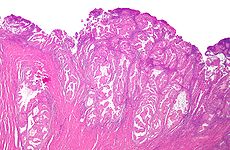Last updated: May 01, 2013
Study establishes basis for genomic classification of endometrial cancers

Study establishes basis for genomic classification of endometrial cancers
Findings suggest proper categorization is important for choosing the best treatment
 |
Bethesda, Md., Wed., May 1, 2013 - A comprehensive genomic analysis of nearly 400 endometrial tumors suggests that certain molecular characteristics - such as the frequency of mutations - could complement current pathology methods and help distinguish between principal types of endometrial tumors, as well as provide insights into potential treatment strategies. In addition, the study, led by investigators in The Cancer Genome Atlas (TCGA) Research Network, revealed four novel tumor subtypes, while also identifying genomic similarities between endometrial and other cancer types, including breast, ovarian, and colorectal cancers.
These findings represent the most comprehensive characterization of the molecular alterations in endometrial cancers available to date. They were published May 2, 2013, in the journal Nature. TCGA is funded and managed by the National Cancer Institute (NCI) and the National Human Genome Research Institute (NHGRI), both part of the National Institutes of Health.
"With this latest study in a series of 20 planned TCGA tumor-type characterizations, more genomic similarities are emerging between disparate tumor types," said NIH Director Francis S. Collins, M.D., Ph.D. "Teasing out heretofore unknown genomic markers or mutations in various cancers is again proving the value of TCGA."
Endometrial cancer is the fourth most commonly diagnosed cancer among women in the United States. NCI estimates that close to 50,000 women will be diagnosed with endometrial cancer in 2013, with more than an estimated 8,000 deaths from the disease. For a majority of patients diagnosed with aggressive, high-grade tumors with metastases, the five-year survival rate is about 16 percent, though chemotherapy has been associated with an improvement in survival, and new targeted agents are being tested.
Clinically, endometrial cancers fall into two categories: endometrioid (type I) and serous (type II) tumors. Type I is correlated with excess estrogen, obesity, and a favorable prognosis, while type II is more common in older women and generally has a less favorable outcome. Type I tumors are often treated with radiation therapy, which helps stop or slow cancer growth, given in addition to or after the primary treatment. Type II tumors are generally treated with chemotherapy, in which drugs are used to kill the cancer cells or stop them from growing.
Distinguishing between different types of endometrial cancers is currently based on histology, an examination of a thin slice of tissue under a microscope. But categorizing endometrial cancer tissues is often difficult, and specialists frequently disagree on the classification of individual cases.
In this study, investigators showed that approximately 25 percent of tumors that pathologists classified as high-grade endometrioid showed frequent mutations in TP53, a tumor suppressor gene, as well as extensive copy number alterations, a term for when a cell has too many or too few copies of a genomic segment. Both are key molecular characteristics associated with serous tumors, along with a small number of DNA methylation changes, which are additions of a basic chemical unit to pieces of DNA. Most endometrioid tumors, by contrast, have few copy number alterations or mutations in TP53, though there are frequent mutations in other well known cancer-associated genes, including PTEN, another tumor suppressor gene, and KRAS, a gene involved in regulating cell division.
These data suggest that some high grade endometrioid tumors have developed a strikingly similar pattern of alterations to serous tumors, and may benefit from a similar course of treatment.
"This study highlights the fact that some tumors with the same characterization by pathologists may have very different molecular features. That's where these findings will be directly implemented in additional research, and also in the context of clinical trials," said Douglas A. Levine, M.D., head of the Gynecology Research Laboratory at Memorial Sloan-Kettering Cancer Center, New York, and a co-leader in the study.
According to the authors, the new findings provide a roadmap for future clinical trials for endometrial cancer. "Each tumor subtype might warrant dedicated clinical trials because of the marked genomic differences between them that are indicative of different drivers of cancer," said study co-leader Elaine Mardis, Ph.D., co-director of the Genome Institute at Washington University School of Medicine in St. Louis. "Developing therapies for each subtype independent of the other may improve outcomes, as has been shown in breast cancer."
Investigators also found genomic similarities between endometrial cancers and other tumor types. Previous TCGA research showed that a form of ovarian cancer (high-grade serous ovarian carcinoma) and a subtype of breast cancer (basal-like breast cancer) share many genomic features. In this study, the scientists found that endometrial serous carcinoma also has some of these same genomic characteristics. The cancers share a high frequency of mutations in TP53 (between 84 and 96 percent) and a low frequency in PTEN, with only 1 to 2 percent mutated. Surprisingly, the researchers also found many shared characteristics between endometrioid tumors and colorectal tumors. Both cancer types demonstrate a high frequency of microsatellite instability, where the repair mechanism for DNA is broken, and mutations in POLE, a gene responsible for producing a protein involved in DNA replication and repair. These genomic changes led to high mutation rates in both tumor types.
"TCGA's multidimensional approach to collecting genomic data, including clinical and pathology information, have made these findings possible," said Harold Varmus, M.D., NCI director. "Without the integrated characterization of so many tumor samples, correlations between histology and genomic data may not have been observed or potential clinical outcomes identified."
With a complete analysis of the study's findings, investigators have identified four novel genomic-based subtypes of endometrial cancer, which may set the stage for new diagnostic and treatment approaches. Each of the four genomic subtypes was clustered and named for one of its notable characteristics:
- The POLE ultramutated group was named for its unusually high mutation rates and hotspot mutations (sequences highly susceptible to mutation) in the POLE gene.
- The hypermutated microsatellite instability group exhibited a high mutation rate, as well as few copy number alterations, but did not carry mutations in the POLE gene.
- The copy number low group showed the greatest microsatellite stability but a high frequency of mutations in CTNNB1, a gene critical for maintaining the linings of organs, such as the endometrium.
- The copy number high subtype was composed of mostly serous tumors, but included some endometrioid samples. This subtype displayed copy number alterations and a mutation landscape that was characteristic of serous tumors.
"Finding genomic similarities among types of breast, ovarian, endometrial and colorectal tumors once again reveals that cancer, although very complex, may have themes extending beyond tissue type that can be exploited for therapeutic benefit," said Eric D. Green, M.D., Ph.D., NHGRI director. "These similar genomic features demonstrate hitherto unknown commonalities among these cancers."
To date, the TCGA Research Network has generated data and published analyses on glioblastoma multiforme, ovarian serous adenocarcinoma, colorectal adenocarcinoma, lung squamous cell carcinoma and invasive breast cancer. Data generated by TCGA are freely available at the TCGA Data Portal and CGHub.
This work was supported by the following grants from the NIH: 5U24CA143799-04, 5U24CA143835-04, 5U24CA143840-04, 5U24CA143843-04, 5U24CA143845-04, 5U24CA143848-04, 5U24CA143858-04, 5U24CA143866-04, 5U24CA143867-04, 5U24CA143882-04, 5U24CA143883-04, 5U24CA144025-04, U54HG003067-11, U54HG003079-10 and U54HG003273-10 and supplemented by the Recovery Act.
More details about The Cancer Genome Atlas, including Quick Facts, Q&A, graphics, glossary, a brief guide to genomics and a media library of available images can be found at http://cancergenome.nih.gov.
Reference: The Cancer Genome Atlas Research Network. Integrated Genomic Characterization of Endometrial Carcinoma. Nature. May 2, 2013. DOI:10.1038/nature12113.
NHGRI is one of the 27 institutes and centers at the National Institutes of Health, an agency of the Department of Health and Human Services. The NHGRI Division of Intramural Research develops and implements technology to understand, diagnose and treat genomic and genetic diseases. Additional information about NHGRI can be found at its website, http://www.genome.gov.
NCI leads the National Cancer Program and the NIH effort to dramatically reduce the burden of cancer and improve the lives of cancer patients and their families, through research into prevention and cancer biology, the development of new interventions, and the training and mentoring of new researchers. For more information about cancer, please visit the NCI website at http://www.cancer.gov or call NCI's Cancer Information Service at 1-800-4-CANCER (1-800-422-6237).
About the National Institutes of Health (NIH): NIH, the nation's medical research agency, includes 27 institutes and centers and is a component of the U.S. Department of Health and Human Services. NIH is the primary federal agency conducting and supporting basic, clinical, and translational medical research, and is investigating the causes, treatments, and cures for both common and rare diseases. For more information about NIH and its programs, visit http://www.nih.gov.
Posted: May 1, 2013